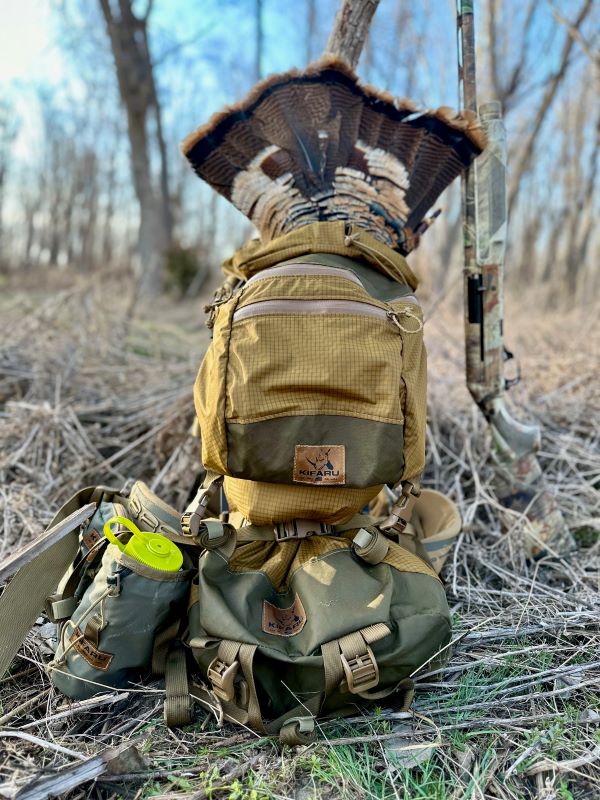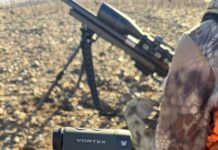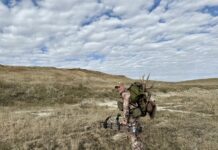
After the 2024 big game season, I took a look at my old faithful Kifaru Duplex Framed/Nomad Bag pack. Covered in multiple years of blood, dirt, and sap and sporting a moldy P&J sandwich smashed into the bottom, I decided enough was enough.
Buy Once, Cry Once?
If you are like me, you love to justify your purchases with the line, “This will be the last one I ever buy; it’ll last a lifetime.” Whether it’s a pair of Swarovski binoculars, a Kowa spotter, or, in this case, a Kifaru Duplex and Nomad bag, the once-in-a-lifetime purchase never seems to last a lifetime.
Kifaru has always been good to me, and with many pack-outs through the last decade, I had no reason to look elsewhere. As usual, though, that did not stop me from wondering if there was something else that was better.
Background
When I saw Kifaru tease a new frame and multiple new packs, I contacted Robby Denning, Rokslide’s Editor, expressing my interest in the new ARK frame and wondering out loud if upgrading was worth the cost (over $900 for the frame and pack). I told him I’d love to see a comparison review for the thousands of us who already have some version of the Kifaru Duplex frame.
Robby and I met at the Kifaru booth at the Western Hunting Expo in Salt Lake. Robby had already pitched the idea to Anders, Kifaru’s General Manager. Kifaru’s always up for a challenge, and Anders gave me an ARK frame and KU4300 to compare. There were no strings attached for my review—I could say it like it is (like all Rokslide reviews).
My goal in this review is to help answer the question, “Is the Kifaru ARK frame worth the upgrade over my current Duplex frame.”

Kifaru ARK Frame
The Kifaru ARK Frame retails for $500. It comes in two different lengths, 22” and 25”, and has an advertised weight of 3.1 pounds. Kifaru set out to create a frame that increased both heavy and light load hauling comfort in a lighter, more adjustable package. To do this, Kifaru completely redesigned its frame sheet, moving to carbon fiber, which maximized strength and weight savings.
They also moved to a new foam in their shoulder straps, belt, and lumbar pad. The big advantage of the new foam is that its life expectancy is many times that of the old foam used in the Duplex frames. The foam has more bounce to it, and the lumbar pad has a a more square shape than previous Duplex lumbar pads. At first, the lumbar pad felt like it was jabbing me in the back, but after a couple of hikes and multiple miles, it broke in and was a non-issue. I spoke with Aron Snyder at Mile High Expo in Denver later, and he recommended putting a 45-pound plate on the lumbar pad overnight to accelerate the break-in process.
Easier To Adjust Fit
Aron and Anders emphasized the importance of ease of adjustment and increased versatility in the new frame. I can confirm that adjusting shoulder straps, attaching bags, and ensuring the overall fitment of the frame and bag system for the user is significantly easier with the new ARK.

| WEIGHTS IN POUNDS | ||
| FRAME | ||
| ARK | DUPLEX | |
| BARE | 3.1 | 3.6 |
| W/ LOAD SLING | 3.7 | |
| W/ LOAD SLING AND 2 POCKETS | 4.0 | |
| W/ KU4300 | 5.0 | |
| W/ KU4300, NO LID AND 2 POCKETS | 5.3 | |
| W/ KU4300, LID, AND 2 POCKETS | 5.9 | |
| W/ NOMAD AND 2 POCKETS | 6.4 | |
Kifaru KU4300
The KU4300 bag retails for $255 without the lid and $345 with the lid. Without the lid, it offers 4300 cubic inches, but with the lid and the snow collar extended, it adds an additional 750 cubic inches, for a total of over 5000 cubic inches.
While this is not a review of the KU4300 specifically, here are my thoughts. I would describe the KU bag as a compromise, a give-and-take.
The good: (this is obvious) the weight. The bag without straps weighs 1.4 pounds, and even with the straps, it weighs 1.9 pounds. Add the lid, and you have a 5000-plus Cubic Inch bag that weighs a paltry 2.5 pounds on my scale.
Easier To Clean
The next positive is the material. The KU material will not absorb blood. Wet blood wipes off with a paper towel, and dry blood comes off with a wet paper towel. Not only will it not absorb blood, but it won’t absorb dirt, dust, mud, water, or basically anything else. A dirty, smelly pack with the KU material is a thing of the past. Anybody who has tried to get blood out of a Cordura bag knows what an impossible feat it is and can appreciate being able to simply wipe out would-be stains.
Great For Wet Weather
While Kifaru was quick to say the KU4300 is not waterproof, in my experience, it is waterproof. My Kifaru Nomad Cordura bag has worn away most of its waterproof coating, and last archery elk season, after a week straight of rain, nothing was dry, including my bag, which also gained a significant amount of weight.
The Not-So-Good
While Kifaru intentionally made the KU4300 simplistic, many users may wish for additional pockets, a meat shelf, or even laser-cut moly to attach pockets inside and out. While this is a drawback, adding the Kifaru load sling makes a great meat shelf for anybody who doesn’t want to throw a bloody quarter on their sleeping bag or puffy jacket. The next potential issue with the KU material is noise. There is no getting around the fact that the ultra-grid is louder than the Cordura. While using a decibel reader, scratching the fabric with an antler to mimic stalking through sage or willows, the KU material came in 8-10 decibels louder than the Cordura (measured at 6 inches).
KU vs Cordura
I was told that the KU material was even louder in freezing temperatures, but the decibel reader did not measure any sound difference, though the material was noticeably stiffer after coming out of a freezer set at -5 degrees. While the KU material was louder than Cordura, I personally do not believe this is a deal breaker for me. Both materials are loud when rubbing against brush and on a stalk; leaving the pack behind is the only guaranteed way to keep the pack material quiet.
The KU4300 has a main bag and one pocket at the top of the bag. I would like to see some laser cut moly on the inside and outside of the bag to add additional storage pouches. The KU4300 could also be described by some as “strappy.” I personally will happily give up a few ounces of additional weight to have more straps to tighten down big loads or attach awkward loads such as heads and antlers. (Tony Treitch also independently reviewed the KU bag here )
ARK OR DUPLEX?

The Duplex and ARK are both great frames. If someone expects to be blown away by the differences in load-carrying ability of the ARK, they are most likely going to be disappointed. The major difference in fit and feel was the lumbar pad. After getting the new lumbar pad broken in, I found that it fits the small of my back much better due to its square shape. The heavy load felt locked in, and I did not have that feeling of the lumbar pad trying to push down my pants that I always had with the Duplex.
Clear Winner
When comparing the Duplex and the ARK, in my opinion, the ARK wins in all categories, minus the price, which is a difference of 50 dollars. The ARK is ½ pound lighter than my Duplex and is more rigid. Where the ARK really shines is its versatility, in major part due to the ease of adjustability. The comparison becomes much murkier when trying to decide if the ARK frame is worth the upgrade to someone who already owns a Duplex. To help answer this question, I am going to give some reasons why the ARK is superior and give a specific example of when upgrading to the ARK is the obvious choice.
If I did a full review of the ARK frame, it would be titled “Kifaru ARK Frame, Adjustable and Versatile.” The ARK’s ease of adjustment allows the user to quickly and easily change bags and add a load sling to create a load shelf. Or, remove the bag and use only the load shelf for training or shed hunting.
Easier To Configure
When adjusting my Duplex frame, I had to video the process so I did not confuse myself when putting it back together. The ARK goes back together in seconds, with no need to remember the steps. I never removed the bag off my Duplex frame or even took the pockets off the sewn-in loops on the belt because it was a pain. The versatility of the new system allows the user to easily configure the frame, bag, and attachments to the intended use for that hunt or even that day. Going from day-hunt mode to meat-hauling mode to spike-camp mode can be done on the tailgate in seconds.

Turkey Hunting
While turkey hunting this year, a buddy with a Kifaru Tactical frame and Mountain Warrior bag helped test the ARK. We loaded them up with gear, plus 80-pound concrete bags, and took off up the foothills to chase Meriams. Each bag was in the 100-110 pound range. Before putting on the pack, he said, “I really hope I don’t like the frame; I don’t want to spend money on a new setup.”
When he put it on and adjusted it, which took seconds, he replied, “holy s***, what a difference!” It turned out that his frame, having packed a lot of heavy loads over the years, was in rough shape. His shoulder straps had zero padding, his lumbar pad had lost all its rigidity, and his belt felt floppy from the foam breaking down. I put his frame and bag on and immediately knew this was the Duplex user who could absolutely justify a new frame. I would encourage anybody with a frame that has seen moderate to heavy use over the years to look at the foam in their belt, shoulder straps, and lumbar. The foam breaks down slowly, and in my buddy’s case, he had no idea his frame had gotten that bad because he had nothing to compare it to. Pricing out new shoulder straps, lumbar and belt, the price to bring his Duplex back to life was $270, more than half the cost of the new ARK.

Conclusion
So, is it worth it? For me, yes, it is, but I like the latest and greatest gadgets. For someone who buys something and uses it until failure, maybe not. The Duplex is still a great frame, but it has limitations compared to the new technology built into the ARK frame.
Comment or ask Gian questions here.




















